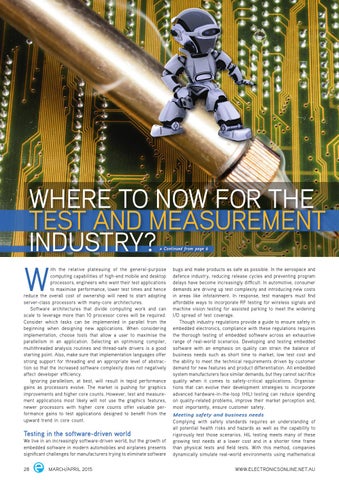WHERE TO NOW FOR THE TEST AND MEASUREMENT INDUSTRY? Âť Continued from page 6
W
ith the relative plateauing of the general-purpose computing capabilities of high-end mobile and desktop processors, engineers who want their test applications to maximise performance, lower test times and hence reduce the overall cost of ownership will need to start adopting server-class processors with many-core architectures. Software architectures that divide computing work and can scale to leverage more than 10 processor cores will be required. Consider which tasks can be implemented in parallel from the beginning when designing new applications. When considering implementation, choose tools that allow a user to maximise the parallelism in an application. Selecting an optimising compiler, multithreaded analysis routines and thread-safe drivers is a good starting point. Also, make sure that implementation languages offer strong support for threading and an appropriate level of abstraction so that the increased software complexity does not negatively affect developer efficiency. Ignoring parallelism, at best, will result in tepid performance gains as processors evolve. The market is pushing for graphics improvements and higher core counts. However, test and measurement applications most likely will not use the graphics features, newer processors with higher core counts offer valuable performance gains to test applications designed to benefit from the upward trend in core count.
Testing in the software-driven world We live in an increasingly software-driven world, but the growth of embedded software in modern automobiles and airplanes presents significant challenges for manufacturers trying to eliminate software
28
MARCH/APRIL 2015
bugs and make products as safe as possible. In the aerospace and defence industry, reducing release cycles and preventing program delays have become increasingly difficult. In automotive, consumer demands are driving up test complexity and introducing new costs in areas like infotainment. In response, test managers must find affordable ways to incorporate RF testing for wireless signals and machine vision testing for assisted parking to meet the widening I/O spread of test coverage. Though industry regulations provide a guide to ensure safety in embedded electronics, compliance with these regulations requires the thorough testing of embedded software across an exhaustive range of real-world scenarios. Developing and testing embedded software with an emphasis on quality can strain the balance of business needs such as short time to market, low test cost and the ability to meet the technical requirements driven by customer demand for new features and product differentiation. All embedded system manufacturers face similar demands, but they cannot sacrifice quality when it comes to safety-critical applications. Organisations that can evolve their development strategies to incorporate advanced hardware-in-the-loop (HIL) testing can reduce spending on quality-related problems, improve their market perception and, most importantly, ensure customer safety.
Meeting safety and business needs Complying with safety standards requires an understanding of all potential health risks and hazards as well as the capability to rigorously test those scenarios. HIL testing meets many of these growing test needs at a lower cost and in a shorter time frame than physical tests and field tests. With this method, companies dynamically simulate real-world environments using mathematical
WWW.ELECTRONICSONLINE.NET.AU
